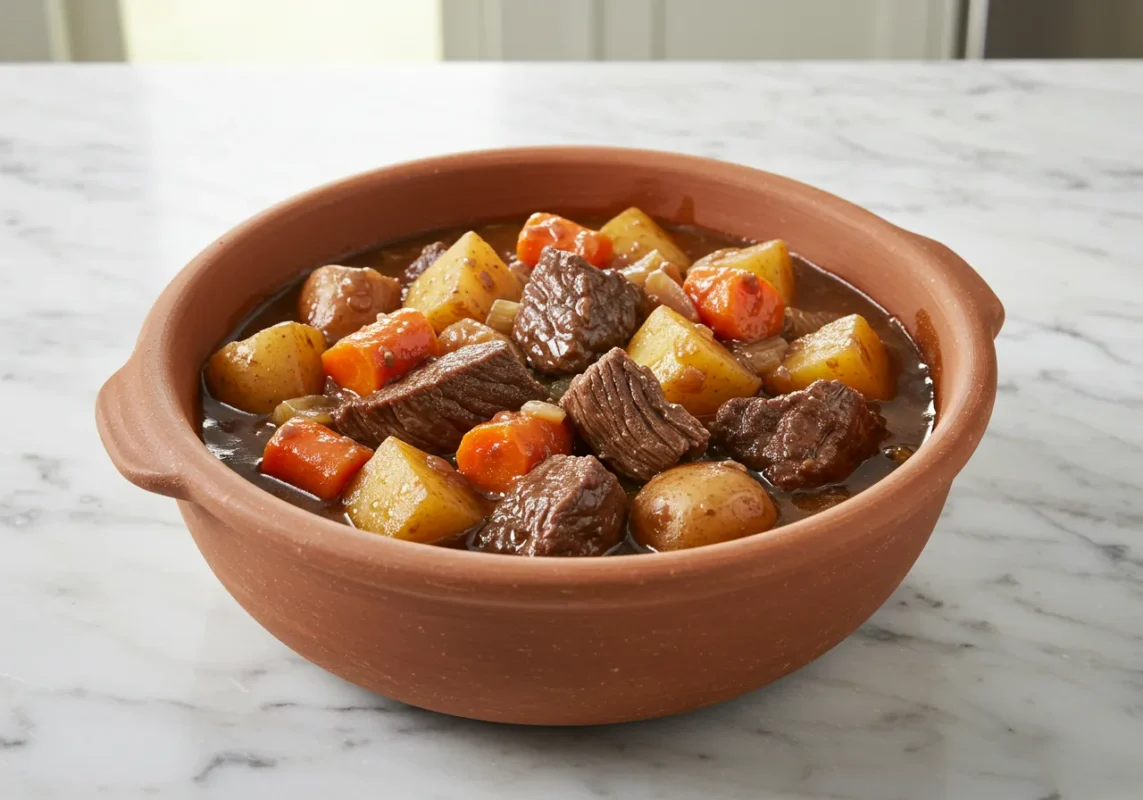Introduction
When the weather turns chilly, there’s nothing quite like indulging in a hearty bowl of beef stew. The aroma filling your home, the rich and savory flavors dancing on your palate—this comforting dish has a way of bringing warmth to both your body and spirit. Today, we will dive into the world of beef stew, focusing specifically on irresistible beef stew recipes in the crockpot.
With the ease and convenience that slow cooking provides, you can create magnificent, tender stews without spending all day in the kitchen. We will explore various aspects of preparing beef stew, including whether or not to brown your meat, the importance of key ingredients, and common mistakes to avoid. Each section will be packed with insights, tips, and, of course, delectable recipes tailored for your trusty crockpot.
The Importance of Browning Stew Meat
Browning stew meat before adding it to the crockpot is a hotly debated topic among home cooks. However, it is often regarded as a valuable step in preparing beef stew. Searing the meat not only enhances the overall flavor through caramelization but also forms a delectable crust that adds depth to your dish. When meat is browned, it develops a rich, complex flavor that simply cannot be achieved by slow cooking alone. This process allows the flavors to develop and create a robust taste that infuses throughout your stew.
Additionally, browning the meat helps to lock in juices and create a better texture. When cooked, raw meat tends to release moisture, which can dilute the flavors in your stew, making it taste more bland. By taking the time to brown your beef, you create a satisfying texture and enhance the overall dining experience. It’s a small step that pays big dividends, allowing each bite of your beef stew to be a flavorful experience.
Recipe
Classic Slow Cooker Beef Stew
Step 1: Ingredients
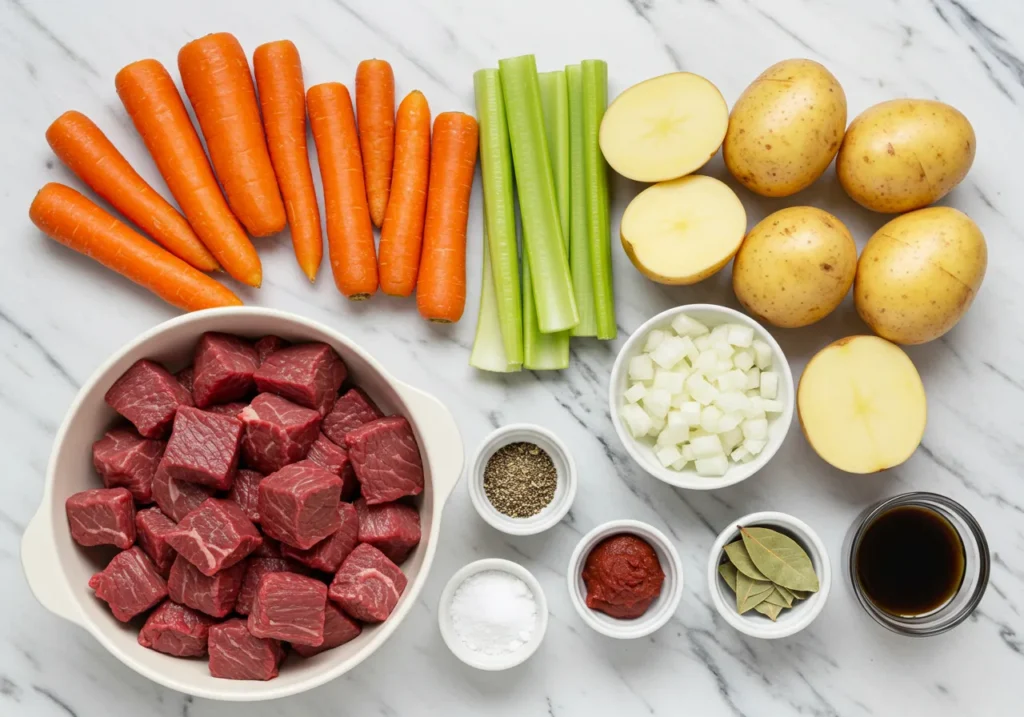
Step 2: In a large bowl, toss beef in flour
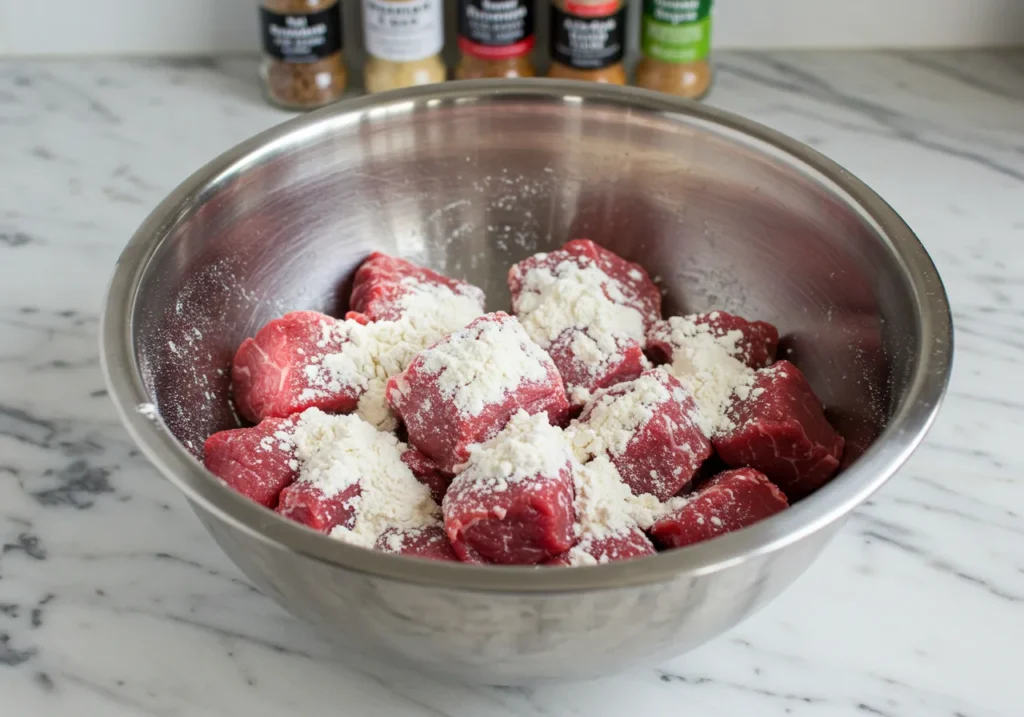
Step 3: After browning Beef, Arrange the carrots, potatoes, celery, onions, and garlic over the beef in the crockpot.
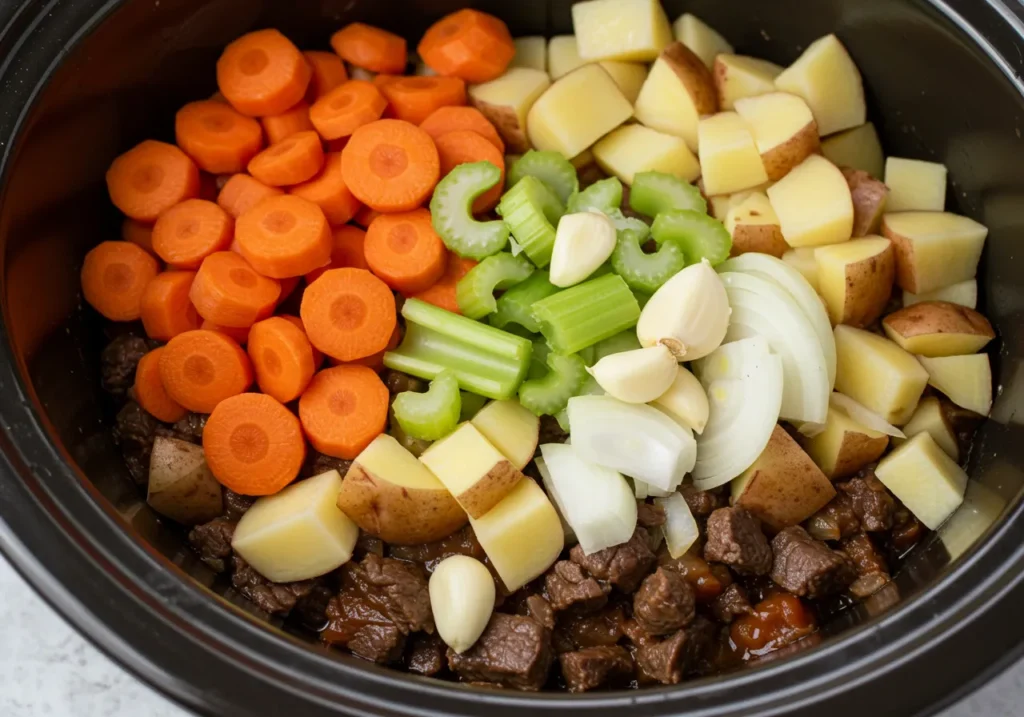
Step 4: Add Liquids and Seasonings, Cover and slow cook, Taste and Adjust before serving
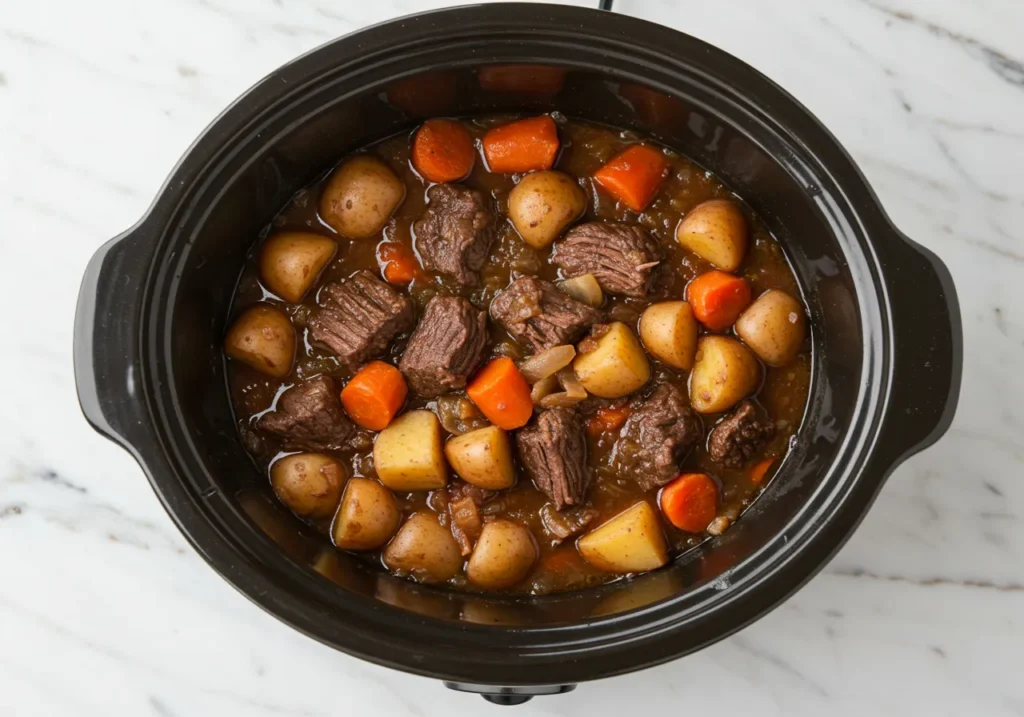
The Secret Ingredient in a Stew
Many seasoned chefs swear by the addition of tomato paste as a secret ingredient in their beef stew recipes in the crockpot. This simple addition packs a punch, providing acidity and depth that balances out the richness of the beef. The umami flavor from tomato paste elevates the overall profile of the dish, creating a luscious and hearty stew that feels perfect for any occasion. It not only enriches the flavor but also thickens the stew, contributing to a velvety texture.
Moreover, tomato paste helps in adding a vibrant color to your stew, making it visually appealing and increasing its allure on the dinner table. The combination of acidity from the tomatoes and the fats from the beef creates a harmonious balance that invites compliments from guests and family alike. Integrating this secret ingredient is a simple trick that can transform your stew from average to extraordinary.
Tasty
Print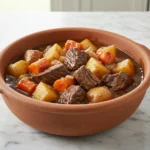
Beef Stew Recipes in Crockpot
- Total Time: 8 hours 20 minutes
Description
Classic Slow Cooker Beef Stew is a comforting dish featuring tender beef, hearty vegetables, and rich broth, all slow-cooked to perfection for a flavorful, cozy meal. Ideal for gatherings or busy weeknights, this stew delivers warmth and satisfaction in every bowl.
Ingredients
- 2 pounds of chuck roast, cut into 1-inch cubes
- 3 medium carrots, sliced
- 3 medium potatoes, diced
- 2 stalks of celery, chopped
- 1 onion, diced
- 4 cloves of garlic, minced
- 2 cups beef stock (or broth)
- 2 tablespoons tomato paste
- 2 teaspoons dried thyme
- 2 bay leaves
- 1 tablespoon Worcestershire sauce
- Salt and pepper to taste
- ¼ cup of flour (optional)
Instructions
- Prepare the Ingredients: Chop and dice vegetables as directed.
- Coat the Beef (if using): In a large bowl, toss beef in flour.
- Brown the Meat (optional): Heat a large skillet over medium heat. Add olive oil and sear the meat on all sides until browned. Transfer to the crockpot.
- Layer the Vegetables: Arrange the carrots, potatoes, celery, onions, and garlic over the beef in the crockpot.
- Add Liquids and Seasonings: Pour in the beef stock, add tomato paste, Worcestershire sauce, thyme, bay leaves, and season with salt and pepper. Stir gently to combine.
- Slow Cook: Cover and cook on low for 8 hours or high for 4 hours, until the beef is tender and flavors have melded beautifully.
- Taste and Adjust: Before serving, taste the stew and adjust seasonings if necessary, removing bay leaves before serving.
Notes
- Choose Quality Ingredients: Opt for high-quality chuck roast and homemade or low-sodium beef broth for the best flavor.
- Prep in Advance: Chop vegetables and meat the night before for a quick, hassle-free cooking experience.
- Enhance Flavors: After cooking, taste and adjust seasoning; a splash of vinegar can brighten the stew’s flavors.
- Thickening Options: For a thicker stew, consider using a cornstarch slurry or increase the amount of flour used on the meat before cooking.
Disclaimer
Consult your nutritionist for tailored dietary advice. Individual nutritional needs may vary. Adjust cooking times and ingredients as necessary.
- Prep Time: 20 minutes
- Cook Time: 8 hours (Low) or 4 hours (High)
- Category: Main Dish
- Cuisine: American or Fusion
Nutrition
- Serving Size: 6
- Calories: 420-560 per serving
- Fat: 24-32g
- Saturated Fat: 8-10g
- Carbohydrates: 25-35g
- Fiber: 4-5g
- Protein: 35-45g
Raw Beef Can Go Straight into the Slow Cooker
Indeed, raw beef can be placed directly into the slow cooker, and many home cooks appreciate this time-saving step. When you drop raw meat into the pot along with your vegetables and broth, everything melds together beautifully throughout the cooking process. This method allows the beef to soak up all the flavors from the surrounding ingredients, resulting in a satisfying stew. While the flavor resulting from this method may differ slightly from that of seared meat, it remains an effective way to create a delicious meal with minimal effort.
However, while skipping the browning step can save you time, it is important to consider the trade-offs. The taste might not be as complex as its browned counterpart, but the succulent texture of the slow-cooked beef can still deliver an enjoyable experience. In essence, whether you choose to sear or not, you can achieve delightful results in your crockpot, allowing every cook to find a method that suits their lifestyle.
The Secret to Crafting Exceptional Stew
Creating a flavorful beef stew is attainable through an array of techniques and ingredients. Choosing high-quality beef cuts like chuck roast or brisket can make all the difference in your stew’s final flavor and texture. These cuts are rich in collagen and fat, allowing for slow cooking that breaks down the meat into tender bites while retaining moisture. The same attention must also be paid to the choice of broth; using homemade stock or high-quality store-bought options will amplify the stew’s richness significantly.
In addition to quality ingredients, employing various cooking techniques can elevate your stew further. Layering ingredients properly in the crockpot helps build flavor complexity. Start by placing aromatics such as onions and garlic on the bottom, followed by your seasoned beef, and then finish with hearty vegetables and liquid. This method not only ensures even cooking but also allows flavors to intermingle beautifully, creating a delicious one-pot meal that will keep everyone coming back for more.
The Consequences of Not Searing Stew Meat
Neglecting to sear stew meat may seem like a time-saver, but it can lead to a significantly less flavorful dish. Without the Maillard reaction occurring, the meat lacks that rich crust that contributes depth to the overall flavor profile. Consequently, the resulting stew can taste flat or one-dimensional, lacking the complexity that browning provides. Therefore, while not absolutely necessary, searing offers a robust flavor that is hard to replicate.
Beyond flavor, the texture of the stew may also suffer. Unseared meat can result in a less inviting mouthfeel, potentially leading to disappointment at the dinner table. So while it might be tempting to skip this step for convenience, taking the extra time to brown your beef can make a world of difference in creating a savory, rich stew that delights all who partake.
The Order of Ingredients Matters
One common question is whether to place meat or vegetables in the crockpot first. Generally, it is best to layer the ingredients with meat on the bottom. This method of layering ensures that the beef can absorb the juices released by the vegetables, enhancing the overall flavor of the stew. When vegetables like carrots and potatoes are placed atop the beef, they cook through more gently without becoming mushy, allowing them to retain their texture and distinct taste.
Layering also facilitates even cooking, which is essential in a slow cooker. With the right arrangement, each ingredient can reach its optimal tenderness by the end of the cooking time. By following this simple guideline, you can improve not only the taste of your stew but also its presentation, making it a dish you won’t hesitate to serve to guests.
Avoiding Ingredients That Compromise Stew Quality
While crafting your beef stew, there are certain ingredients that one should avoid. For instance, delicate ingredients like leafy greens or seafood may not hold up well to prolonged cooking, leading to a stew that is texturally unappealing. Items such as dairy should also be added only towards the end of the cooking process, as the high heat in a slow cooker can cause milk or cream to curdle, diminishing the quality of your dish.
In addition to considering the ingredients, it’s equally important to watch your quantities. Overloading the crockpot can create uneven cooking conditions, making certain components overcooked while others remain undercooked. To ensure a balanced stew, aim to fill your crockpot to about two-thirds full. This attention to detail will reflect in the final flavor and consistency of your stew.
One Ingredient Upgrade for Better Beef Stew
Adding red wine or balsamic vinegar can significantly enhance the flavor of your stew. The acidity from these ingredients balances the dish’s richness, transforming it into a more complex and satisfying experience. A splash of red wine not only deepens the color of your stew but also introduces an additional layer of flavor that complements the beef wonderfully. Balsamic vinegar, on the other hand, provides a slight sweetness that contrasts beautifully with the savory tones of the meat and broth.
When incorporating red wine, it’s best to allow it to cook down for a bit before adding the remaining ingredients. This gives it a chance to evaporate and concentrate its flavors, intensifying the richness of your stew. Adding vinegar at the end, however, can brighten the flavors and give your stew a fresh note, tantalizing the taste buds and creating a memorable dish.
The Role of Tomato Paste in Beef Stew
As previously mentioned, adding tomato paste gives your stew a wonderful richness. This humble ingredient not only thickens the stew but also enhances its overall taste. By introducing the sweetness of the tomatoes, you create a lovely balance against the savory components, allowing for a multifaceted flavor profile. The presence of tomato paste means that each spoonful becomes a delightful experience, as the vibrant flavors dance together seamlessly.
Additionally, tomato paste aids in achieving a vibrant color, transforming your beef stew into a visually stunning dish that is bound to impress. The deep red hue, combined with the contrasting colors of the vegetables, creates an inviting presentation, encouraging everyone to dive in. By utilizing tomato paste, you’re not just improving the flavor; you’re also elevating the aesthetic appeal of your meal.
Common Mistakes When Using a Slow Cooker
Being aware of common mistakes can elevate your cooking game significantly. One of the most frequent pitfalls is lifting the lid too often while the stew is cooking. Each time you check on your stew, you disrupt the cooking process and cause a drop in temperature, which can lengthen cooking time and affect the tenderness of the meat. To avoid this, plan ahead and give the stew time to develop its flavor without interruptions.
Another common error is not adequately prepping the ingredients. Chopping vegetables too small can lead to them becoming mushy by the end of the cooking time, while larger pieces may remain undercooked. Practicing uniformity in your cuts will not only improve cooking times but also enhance the overall texture of your stew. By avoiding these mistakes, you’ll set yourself up for success and create a consistently delightful result.
Flour is Your Friend!
Dusting meat in flour before slow-cooking can serve multiple purposes. First and foremost, flour acts as a thickening agent, giving your stew a luxurious mouthfeel. When dusted on meat and then seared, it creates a slight crust that locks in juices and enhances the heartiness of the dish. The result is a satisfying, robust stew that boasts not only great flavor but a delightful texture.
Furthermore, floured meat tends to brown better when cooked, contributing to a rich color that makes your stew not only taste wonderful but also look appealing. For optimal effects, consider pre-searing your floured meat in a skillet briefly before dropping it into the slow cooker. This step, while occasionally time-consuming, significantly enriches the overall flavor, offering impressive results that will earn you rave reviews.
Ensuring Tender Chicken While Slow-Cooking
While our focus here is on beef, it’s worth mentioning that if you were to branch into chicken, you must be aware of timing and methods to avoid rubbery meat. Chicken becomes tender and juicy when cooked adequately in a slow cooker, but overcooking can lead to unappetizing results. To prevent this issue, you might consider using chicken thighs instead of breasts, as thighs have more fat and connective tissue, leading to a more forgiving cooking experience.
Managing your cooking time effectively is key here. Chicken typically takes about 4 to 6 hours on low heat in the slow cooker; checking early can help avoid the rubbery texture associated with overcooked chicken. By understanding these details, you can ensure that your slow-cooked meals, whether beef or chicken, come out tender and flavorful, delighting all who are lucky enough to partake.
Deepening the Flavor of Your Beef Stew
Seeking to deepen flavors is essential to crafting a satisfying beef stew. A great starting point is to invest in quality stock or broth. Homemade stock has the advantage of being rich in flavor and can be tailored to your tastes. If you opt for store-bought stock, look for options labeled ‘low sodium,’ which gives you control over salt levels while still maintaining flavor depth. By putting a significant emphasis on your base, you set the stage for a luscious outcome.
In addition to the savory base, consider adding fresh herbs that will infuse your stew with aromatic notes. Fresh thyme, rosemary, and parsley lend subtlety and brightness to your dish. Furthermore, incorporating a few garlic cloves and sautéed onions at the beginning of the recipe will enhance that aromatic foundation. These careful considerations will deepen the flavor and transform your humble beef stew into a culinary masterpiece.
Enhancing Flavor with Vinegar
Vinegar can elevate the overall flavor profile of your dish, providing a tangy brightness that cuts through the richness of the beef. Adding a splash of red wine vinegar or balsamic vinegar towards the end of cooking can pull together the flavors without overwhelming the dish. Acidic components can highlight the sweetness of the tomatoes and enhance the depth of the stew’s overall flavor.
Incorporating vinegar not only uplifts the taste but also helps to tenderize the meat. The acetic acid in vinegar works as a marinade, further breaking down the protein fibers and leading to a succulent final product. By balancing acid and sweetness effectively, you’ll find that vinegar becomes an essential ingredient in your arsenal for cooking beef stew.
The Most Flavorful Meat for Stew
When it comes to beef stew recipes in the crockpot, tough cuts like chuck roast or brisket shine brightest. These cuts are rich in marbling, which means they contain more fat and collagen. As they cook slowly, the connective tissues break down and transform into gelatin, producing a velvety broth that heightens the enjoyment of your stew. The compelling flavor that only these tougher cuts offer makes them the ideal candidates for slow cooking.
Additionally, the choice of meat contributes significantly to the character of your stew. Chuck roast is particularly beloved for its robust flavor, while brisket tends to yield an exquisite tenderness that lingers on the palate. By using these flavorful cuts, you provide a wholesome experience that is sure to impress anyone who sits down to enjoy your beef stew.
Conclusion
Delving into beef stew recipe in the crockpot opens up a world of warming flavors and comforting aromas. Whether you’re a seasoned chef or a culinary novice, these recipes and tips will guide you in crafting the ultimate beef stew that friends and family will gather to enjoy. With each comforting bowl, you’ll not only warm bodies but souls too.
Dare to experiment with flavors, embrace the simplicity of slow cooking, and relish the joy of sharing a hearty meal. Explore our irresistible beef stew recipes in the crockpot today and savor every delightful bite!

